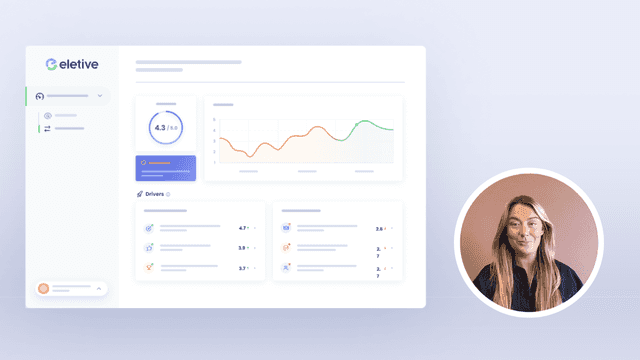Measuring eNPS is a great way to monitor the employee experience and measure employee engagement in your organisation. So, what is a good eNPS score? That’s what we’ll have a closer look at here.
A good eNPS score is desirable for many reasons. It indicates happy and engaged employees, a strong employer brand, and it’s a predictor of high retention and high employee loyalty. A low eNPS score, on the other hand, is a considerable risk factor. It indicates the opposite: unhappy employees, a weak employer brand, and it’s a predictor of high employee turnover.
Calculating the eNPS Score
Before we dive into what a good eNPS score is, let’s have a look at how it’s calculated.
The eNPS, or Employee Net Promotor Score, is calculated with the following formula: eNPS = percentage of Promoters minus percentage of Detractors. The eNPS score ranges from -100 to +100.
The eNPS survey is just one single question:
”How likely is it that you would recommend your employer to a friend or acquaintance?”
Respondents answer by picking a number on a range from 0 to 10, where 10 represents “Extremely likely” and 0 represents “Not at all likely”. The responses are divided into Promoters (9, 10), Passives (7,8), and Detractors (0-6).
Understanding your eNPS results
The genius of the eNPS lies in the simplicity of the eNPS question. With just one question, it captures how happy your employees are with their employee experience. So, how do you know what a good eNPS score is?
Our guidelines on how to interpret your eNPS score (= Promoters (%) – Detractors (%)) are as follows:
0 – 20 is Good
20 – 50 is Very good
Above 50 is Excellent
How can eNPS surveys help build a positive work culture?
Employee Net Promoter Score (eNPS) surveys are a powerful tool for fostering a positive work environment. By gauging employee sentiment, these surveys offer invaluable insights into the current state of your organization's culture.
Revealing employee sentiment
One key way eNPS surveys help is by shedding light on how employees feel about their workplace. These surveys go beyond mere scores, often incorporating qualitative feedback that can highlight areas of strength and concern. Positive remarks usually point to a supportive culture where employees feel appreciated and valued. On the flip side, negative comments can uncover issues like gender discrimination or a lack of psychological safety, which need to be addressed urgently.
Measuring culture through scores
The balance of promoters (employees likely to recommend your organization) versus detractors (those unlikely to recommend) provides a clear snapshot of your company culture. A high number of promoters typically signals a thriving work environment. In contrast, a surge in detractors may indicate underlying cultural problems that require immediate attention.
eNPS score by industry
Another way to understand your eNPS score, is to put it in relation to the eNPS results of other teams or organisations. When you benchmark eNPS score from your organisation against, for example, other companies in your industry, you get a sense of how well your company is doing and if there is anything you need to change to retain your employees.
eNPS benchmarks – a global standard
Using a global standard like the eNPS means you get data that can easily be compared to other organisations. eNPS benchmarks can be used globally, and allows you to compare your eNPS results to average enps scores and the benchmarks in your industry. This works even if others are using different eNPS tools, as long as they adhere to the eNPS survey structure.
With Eletive you can easily see the the average eNPS score by industry, and benchmark against it. You can also use internal benchmarking, and compare different segments in your organisation.
However, the eNPS score doesn’t tell you what is working or not working. It only shows you to what extent your employees are happy. This is why, on its own, it doesn’t take you all the way.
Instead, you’ll want to add the eNPS question to regular employee surveys that provide more in-depth insights. By regularly measuring all the drivers of employee engagement with intelligent pulse surveys, you will not only understand the employee experience better. You will also be able to see exactly how you can improve it. With Eletive, you can:
Monitor Trends Over Time: Keep an eye on how employee sentiment evolves.
Compare Across Departments: Identify which teams are thriving and which need support.
Proactively Identify Areas for Improvement: Spot potential issues before they escalate.
By utilizing powerful automation tools alongside eNPS surveys, organisations can foster a more engaged and productive work environment. This leads to improved employee retention and overall business success. Combining eNPS data with pusle surveys ensures that your eNPS data is not just collected but effectively used to transform your workplace.
Identify areas of improvement: eNPS surveys allow employees to share feedback anonymously. By gathering feedback alongside the score, organizations can identify patterns and areas in need of improvement. For example, if the survey consistently highlights unrealistic deadlines and overwork, it’s clear that changes are necessary. Implementing mental health days, fitness classes, and meditation sessions can help address these issues effectively.
Encourage ownership and participation: eNPS surveys demonstrate that the organization values employees’ opinions and experiences, fostering a sense of participation and ownership. Employees recognise that their input can drive improvements, empowering them to actively find solutions to identified problems. For instance, in a company with many remote employees, workers may feel overwhelmed by constant check-ins and meetings. They may prefer an asynchronous work environment. Through eNPS surveys, they can raise such issues and actively participate in bringing about the desired change.
Invest in employee well-being: eNPS scores indicate where organisations should invest to address employee well-being challenges like high stress, burnout, or work-life balance issues. Initiatives like wellness programs, flexible work hours, and mental health resources demonstrate a commitment to meeting employees’ needs. Various mental well-being programs can be introduced to improve workplace mental health, showcasing the organization’s commitment to its employees.
Focus on building a positive work culture: eNPS survey responses can reveal employees’ sentiments towards the company culture. Positive feedback indicates a supportive culture where employees feel valued. Negative feedback could indicate issues such as gender discrimination or a lack of psychological safety. The ratio of promoters to detractors in eNPS scores also provides clarity on company culture. A high number of promoters indicates an excellent culture, while a predominance of detractors suggests a need to define and improve the company culture.
How the Employee Net Promoter Score (eNPS) differs from traditional satisfaction surveys
The Employee Net Promoter Score (eNPS) stands out from typical employee satisfaction surveys by placing emphasis on advocacy rather than just satisfaction.
Focus on advocacy
eNPS: Measures whether employees would recommend their company to others, reflecting true commitment and loyalty.
Traditional surveys: Typically gauge general satisfaction and contentment with various aspects of the workplace.
In-depth sentiment analysis
eNPS:
Evaluates employees' willingness to promote the company to friends, family, and acquaintances, revealing deeper emotional connections.
Traditional surveys:
Often concentrate on immediate aspects like job roles and working conditions, without delving into advocacy potential.
Engagement indicator
eNPS: Acts as a predictor of employee engagement by assessing how likely employees are to become promoters of their company.
Traditional surveys: Usually measure engagement through a series of questions that might not directly link to advocacy behavior.
Simplified scoring system
eNPS: Uses a straightforward scoring method, typically asking one key question—whether employees would recommend their company.
Traditional surveys: Often involve multiple questions and complex scoring mechanisms to understand overall satisfaction levels.
While traditional employee satisfaction surveys focus on the here-and-now of workplace satisfaction, eNPS provides a clearer picture of long-term loyalty and advocacy. This makes eNPS an invaluable tool for organizations looking to understand and improve their employees’ overall engagement and dedication.
A good eNPS score shows your employees are happy
If someone is willing to recommend their workplace to a friend or an acquaintance, it means they are happy with their employee experience. And happy employees are the foundation for building a strong employee brand and attracting and retaining talent over time.

























